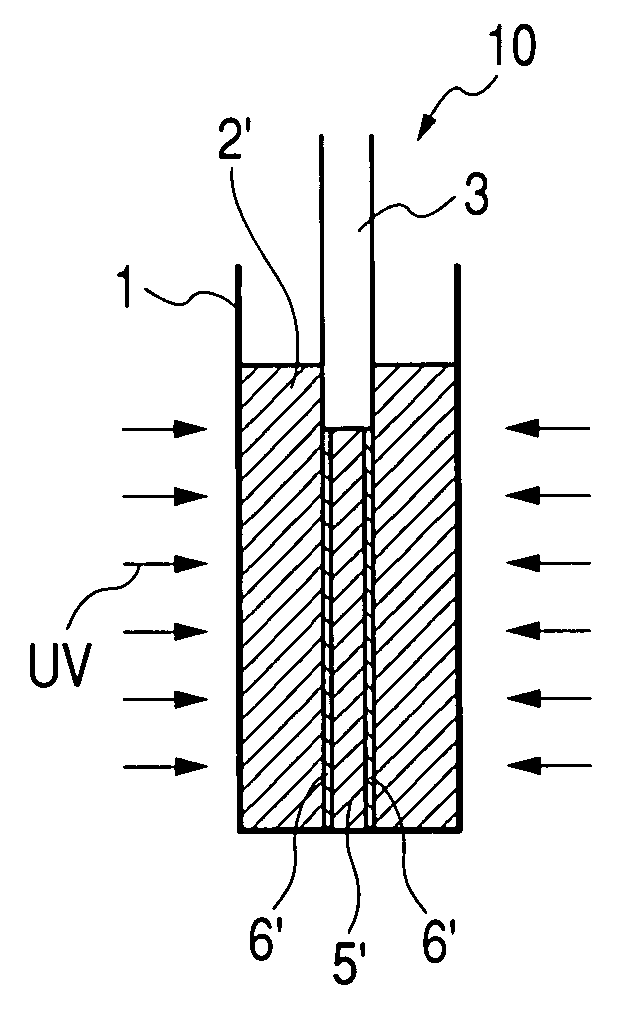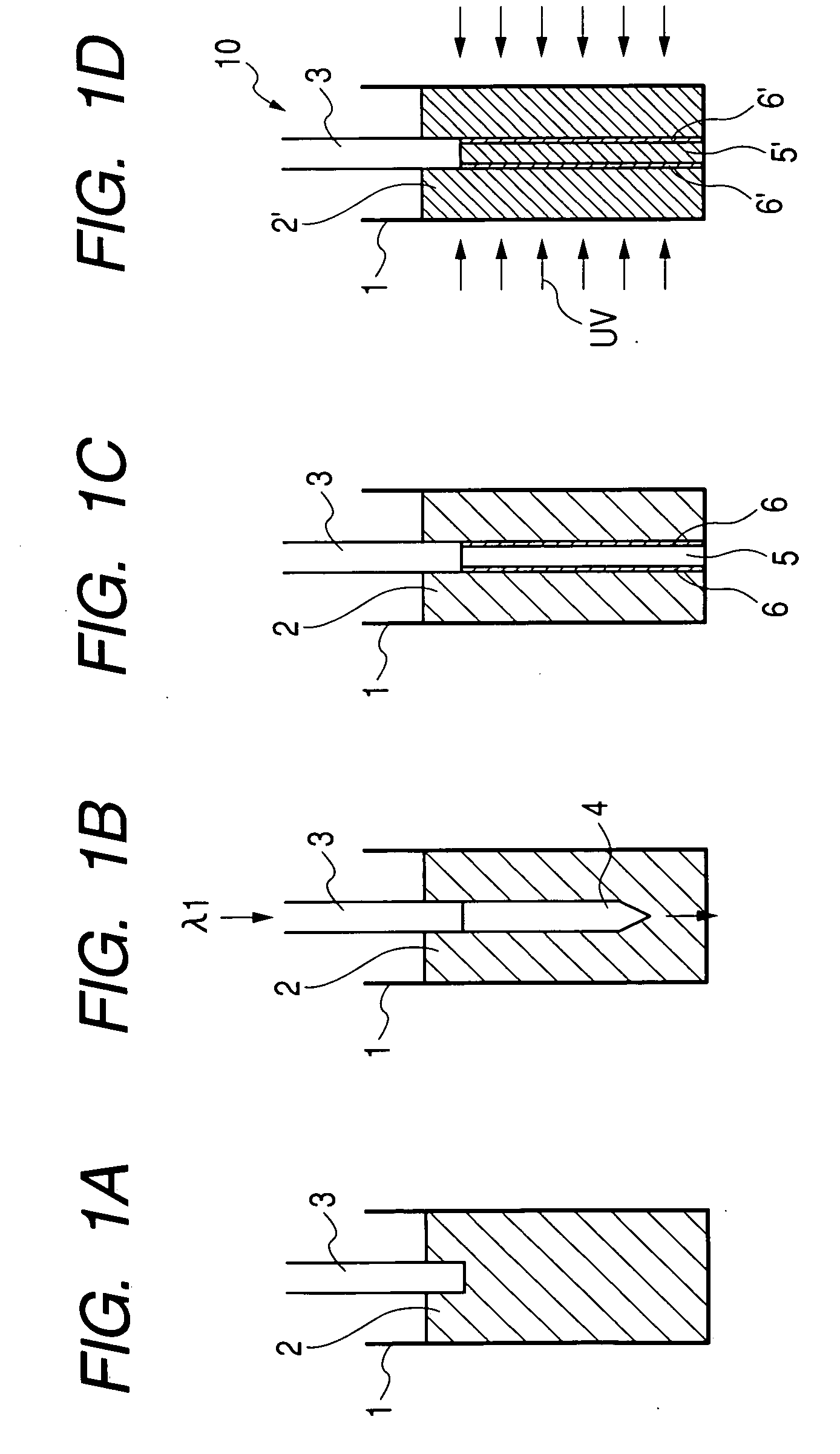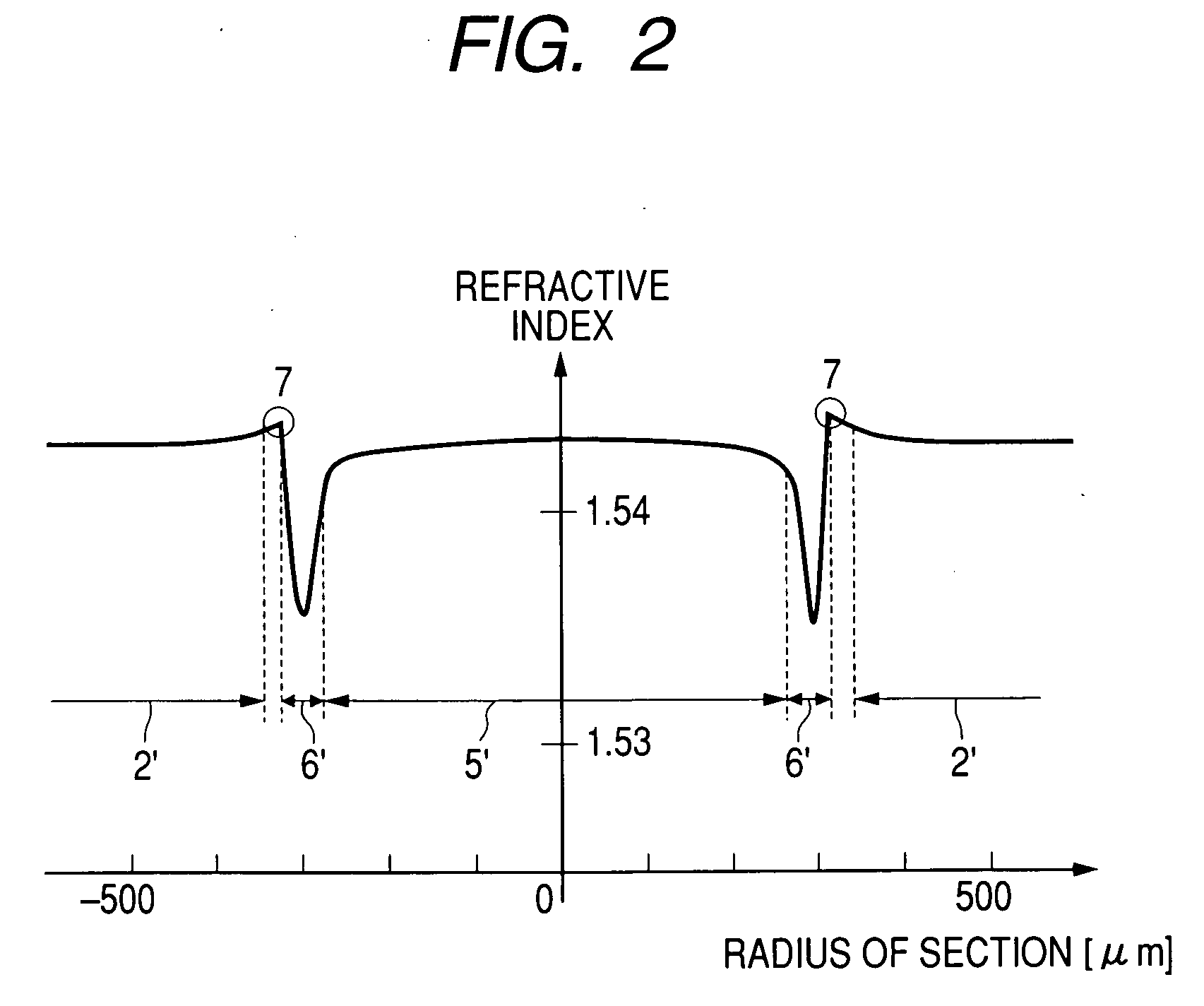Optical waveguide and method for producing the same
a technology of optical waveguides and optical fibers, applied in the direction of instruments, cladded optical fibres, liquid/solution decomposition chemical coatings, etc., can solve the problems of difficult to remove the uncured part of the photo-curable resin solution perfectly, the outer surface of the core becomes so bumpy, etc., and achieves the effect of easy formation
- Summary
- Abstract
- Description
- Claims
- Application Information
AI Technical Summary
Benefits of technology
Problems solved by technology
Method used
Image
Examples
first embodiment
[0060] Sixty parts of radical polymerizable monomer (trade name “SR-454” made by Sartomer Company) with a refractive index of 1.471 and 0.5 parts of radical polymerization type visible-light photopolymerization initiator as the first photo-curable resin solution, and 40 parts of cationic polymerizable monomer (trade name “EPIKOTE 828” made by Japan Epoxy Resin Co., Ltd.) with a refractive index of 1.574 and 3.0 parts of cationic polymerization type ultraviolet-light photopolymerization initiator as the second photo-curable resin solution were mixed to prepare a mixture of the photo-curable resin solutions. The refractive index of the mixture solution was 1.514 before the mixture solution was cured. The refractive index of the cured of the mixture solution was 1.543 after the mixture solution was entirely cured by irradiation with ultraviolet rays. In Example 1, a mixture of the radical polymerizable monomer (trade name “SR-454”) with a refractive index of 1.471 and the radical polym...
second embodiment
[0075] Each of core materials shown in Table 3 was used as a first curable resin solution capable of being cured by a light beam. A mixture containing 108 parts by weight of photo-curable OXT-221 made by Toagosei Co., Ltd. and 2 parts by weight of photo-curable UVR-6110 made by Union Carbide Corp. was used as a second curable resin solution. An optical waveguide was produced as follows. In Table 3, solubility parameter is simply abbreviated to “SP”. The term “SP” is hereinafter used as an abbreviation of “solubility parameter”. The viscosity of the second curable resin solution was 120 mPa·s. The SP of the second curable resin solution calculated on the basis of the SP 18.25 MPa1 / 2 of OXT-221 made by Toagosei Co., Ltd. and the SP 23.44 MPa1 / 2 of UVR-6110 made by Union Carbide Corp. was 19.28 MPa1 / 2. On this occasion, the solubility parameter was calculated in accordance with the Small's calculation method described in “Polymer Handbook 4th edition”, pp.682-685, John Wiley & Sons Inc...
third embodiment
[0080] An optical waveguide 110 was formed in the same manner as in the second embodiment except that a first curable resin solution 101 for forming a core as shown in Table 4 and a second curable resin solution 102 for forming a clad as shown in Table 4 were used. The transmission loss of the optical waveguide 110 was measured. Table 4 and FIGS. 8 and 9 show results of the measurement. FIG. 8 shows the relation between refractive index and specific gravity in five combinations of the first curable resin solution 101 and the second curable resin solution 102 before curing. In this embodiment, defencers OP-38, OP-40, OP-43, OP-44 and OP-47 made by Dainippon Ink and Chemicals, Inc. were used as fluorinated acrylic monomers. These are fluorine-substituted acrylic monomers. The defencer OP-38 is the largest in the amount of substituted fluorine. The defecers OP-40, OP-43, OP-44 and OP-47 are in descending order of the amount of substituted fluorine. For this reason, as the amount of sub...
PUM
| Property | Measurement | Unit |
|---|---|---|
| Fraction | aaaaa | aaaaa |
| Pressure | aaaaa | aaaaa |
| Dynamic viscosity | aaaaa | aaaaa |
Abstract
Description
Claims
Application Information
 Login to View More
Login to View More - R&D
- Intellectual Property
- Life Sciences
- Materials
- Tech Scout
- Unparalleled Data Quality
- Higher Quality Content
- 60% Fewer Hallucinations
Browse by: Latest US Patents, China's latest patents, Technical Efficacy Thesaurus, Application Domain, Technology Topic, Popular Technical Reports.
© 2025 PatSnap. All rights reserved.Legal|Privacy policy|Modern Slavery Act Transparency Statement|Sitemap|About US| Contact US: help@patsnap.com



